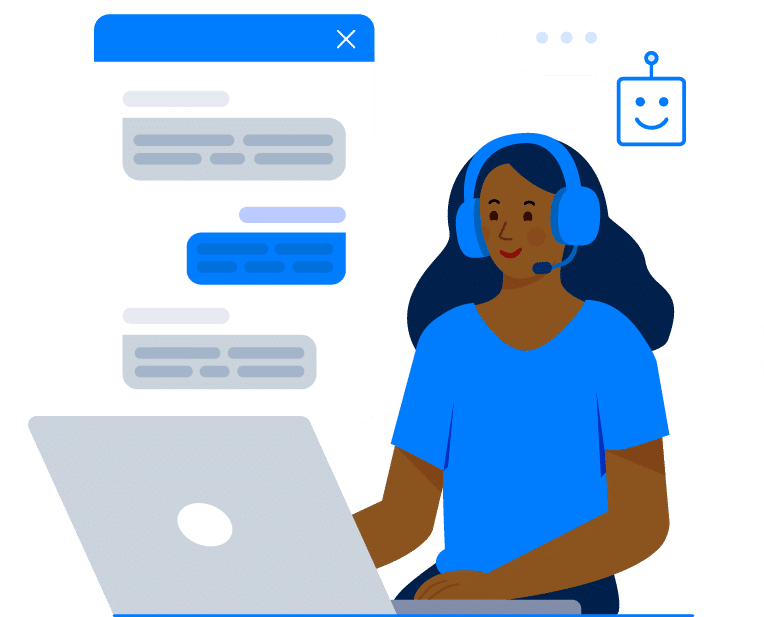In today’s fast-paced business environment, maintaining an efficient and effective call center phone system is imperative for any customer-facing organization. This technology is crucial in managing customer interactions and resolving issues promptly. Modern advancements in voice biometrics, automatic speech recognition (ASR), and natural language processing (NLP) have revolutionized traditional call center phone systems. This guide will explore how these AI-driven technologies can optimize customer support, improve customer experiences, and contribute to better business outcomes, positioning your business for enduring success.
What is a Call Center Phone System?
A call center phone system is a sophisticated suite of hardware and software designed to manage a company’s incoming and outgoing communications. These systems incorporate multiple lines to handle a large volume of calls and are packed with features like interactive voice response (IVR), automatic call distribution (ACD), call recording, and more. With advancements in artificial intelligence, these systems now include voice biometrics, ASR, and NLP to further streamline operations and enhance customer interaction.
These technologies transform typical call center operations by minimizing waiting times, enhancing customer interactions, and providing robust security measures. They replace the antiquated systems that rely solely on human agents, instead creating a dynamic, interactive environment where automated systems and human agents work in tandem to provide the best possible service.
When it comes to support, it’s crucial that businesses use the most efficient tools available to meet customer demand. According to MIT, consumers base 80% of their decision to keep doing business with a brand on the quality of their customer experience. How is your call center stacking up?
How Call Center Phone Systems Optimize Support
Voice Biometrics
Voice biometrics uses unique vocal characteristics, such as pitch, tone, or accent, to verify and authenticate users. This technology relies on several sub-features including speech synthesis and text-to-speech (TTS) technologies.
Speech Synthesis and Text-to-Speech (TTS)
Speech Synthesis converts written words into spoken language. It helps create natural-sounding automated responses, which enhance user experience by providing prompt, consistent, and error-free information.
Text-to-Speech (TTS) ensures that any spoken words are generated clearly and naturally, making automated systems more user-friendly, useful, and accessible.
The incorporation of speech synthesis and TTS into voice biometrics ensures a seamless and interactive user experience, making this technology a crucial component of a modern call center phone system.
Impact on Customer Experience
Personalized Interactions: Voice biometrics can recognize individual callers based on their voice alone, creating personalized and secure interactions. This helps customers feel understood and valued, and improves their overall experience.
Security: By using vocal characteristics for authentication, voice biometrics can offer a high level of security. This reduces the risk of fraud and ensures that sensitive information remains protected, while also raising consumer trust.
Voice biometrics provides a seamless customer experience by eliminating the need for tedious security questions. Instead, customers are authenticated through a unique voice print, allowing agents to quickly access their information and resolve any issues they might have. Businesses who can offer this kind of speed and convenience significantly enhance their overall customer experience.
Business Outcomes
Enhanced Security: Voice biometrics decrease the likelihood of errors and fraud by ensuring that only genuine users can access sensitive information.
Operational Efficiency: Quick and secure authentication processes reduce call handling time, allowing agents to manage more calls more efficiently.
Voice biometrics offer far-reaching benefits for businesses, especially in high-stakes industries like financial services and healthcare where security and compliance are paramount. By ensuring authentic, secure interactions, companies can build trust with their customers, leading to stronger relationships and brand loyalty. Additionally, reducing the time spent on identity verification frees up agents to solve more complex queries, improving overall operational efficiency.
Automatic Speech Recognition (ASR)
ASR technology converts spoken words into written text. This technology helps agents to understand a caller’s intent and sentiment, and also streamlines various aspects of the customer support process.
Impact on Customer Experience
Efficiency in Call Handling: ASR systems can recognize and respond to common customer queries automatically, reducing the need for human intervention. This speeds up the resolution process and reduces the need for customers to repeat themselves.
Improved Accessibility: ASR can transcribe voice commands for hearing-impaired users, ensuring that the service is inclusive and accessible to a broader audience.
When businesses use an AI-powered ASR, they see a significant reduction in customer frustration caused by long wait times and repetitive explanations. Calls are routed more efficiently to the appropriate departments, and routine questions are resolved swiftly through automated responses, ensuring that customers receive help almost immediately.
Business Outcomes
Cost Reduction: ASRs, powered by AI, give agents more time back to focus on more nuanced, complex issues and to provide deeper, more personalized support.
Real-Time Analytics: ASR provides real-time transcription and analysis of calls, producing actionable insights that can be used to improve services and products.
ASR’s ability to transcribe and analyze calls offers tremendous value for businesses and significantly enhances tools like cloud based call centers. It provides a wealth of data that can be harnessed to identify trends, measure agent performance, and pinpoint areas for improvement. Real-time analytics from an ASR can guide agent training programs, optimize resources, and strengthen overall customer service strategies.
Natural Language Processing (NLP)
NLP allows computers to understand, interpret, and respond to human language in a valuable and meaningful way. NLP, and natural language understanding (NLU), greatly enhances the way businesses communicate with their customers.
Impact on Customer Experience
Contextual Understanding: NLP helps systems to understand the context of a customer’s query, even with varying sentence structures and colloquialisms. This ensures that customers receive accurate and relevant responses.
Enhanced Customer Interaction: NLP facilitates more natural and less stilted interactions with call center systems, improving overall customer satisfaction.
NLP’s ability to grasp the nuances and contexts of human language makes it a powerful tool for customer interaction. It ensures that automated responses are accurate and contextually appropriate, reducing misunderstandings and enhancing the overall quality of the service provided.
Business Outcomes
Increased First Call Resolution: By accurately understanding and categorizing queries, NLP enhances the likelihood of resolving issues on the first call, which improves productivity and customer satisfaction.
Data-Driven Decisions: NLP can analyze vast amounts of unstructured data (like call transcripts) to derive insights that guide business strategies and decisions, further enhancing efficiency and effectiveness.
NLP not only improves immediate customer interactions but also provides long-term benefits by converting raw data into meaningful insights. This data can be used to refine customer service protocols, develop training programs, and implement strategic initiatives that align with customer needs and business goals.
If you’re interested in an NLP solution, learn what 5 features to look for in a natural language processor.
Enhancing Customer Experience (CX) with Call Center Phone Systems
Personalized Customer Interactions
A modern call center phone system can provide a level of personalization that traditional systems cannot. With advanced technologies like voice biometrics and NLP, each interaction can be tailored to the individual customer. Personalized greetings, automated follow-ups, and specific responses based on caller history make the customer feel valued and understood.
Technologies such as voice biometrics help in instantly authenticating callers, recognizing returning customers, and recalling their previous interactions. This continuity in service assures customers that they are acknowledged and appreciated, fostering a sense of loyalty and trust towards your business
Faster Issue Resolution
One of the main reasons customers become dissatisfied is the time it takes to resolve their issues. By integrating ASR and NLP into the call center phone system, businesses can significantly reduce first call resolution times. While ASR quickly transcribes and categorizes the issues, NLP understands the context, streamlining the entire process. This direct and efficient handling of customer queries makes for a smoother, more satisfying customer experience.
Fast and efficient service translates to higher customer satisfaction levels and CSAT scores. Customers can get their issues resolved with minimal effort on their part, leading to a more positive perception of your business and higher likelihood of repeat business.
Omnichannel Integration
Today’s customers expect seamless communication across various channels—be it phone, email, chat, or social media. Modern call center phone systems have the ability to integrate and unify interactions across all these channels. Through this seamless omnichannel experience, customers can switch between communication methods without the frustration of starting over, significantly improving their overall experience.
Omnichannel integration ensures that customer interactions are consistent regardless of the channel used. It provides a comprehensive view of customer interactions, enabling agents to deliver a more informed and consistent service.
Accessibility and Inclusivity
With the help of ASR and TTS technologies, call center phone systems can cater to a diverse customer base. For instance, hearing-impaired customers can benefit from real-time transcriptions of voice communications, while foreign language speakers can receive assistance in their native languages, thanks to NLP. This inclusivity ensures that all customers receive the support they need, making them feel more valued and respected.
Inclusive customer service practices enhance brand reputation and loyalty by ensuring that no customer feels marginalized. The ability to serve a diverse customer base well is a significant competitive advantage in today’s global marketplace.
Business Benefits of Modern Call Center Phone Systems
Increased Efficiency and Productivity
Advanced call center phone systems enable businesses to handle more customer queries efficiently. Automation through ASR and NLP reduces the workload on human agents by filtering and responding to routine inquiries, allowing human agents to focus on more complex issues. This results in increased efficiency and productivity within the call center.
With automated systems taking care of the basics, human agents can utilize their skills and expertise to tackle more intricate problems. This not only enhances overall productivity but also ensures that customers receive high-quality support when they need it.
Enhanced Security Measures
Security is a significant concern for both businesses and customers. By implementing voice biometrics, call centers can ensure that each caller’s identity is verified before any sensitive information is exchanged. This not only prevents fraud but also assures customers that their information is safe, building trust and loyalty.
Voice biometrics add an extra layer of security that is difficult to breach. Unlike passwords or PINs, vocal characteristics are unique and challenging to replicate, making this technology a robust defense against fraudulent activities.
Data Analytics for Better Decision-Making
Modern call center phone systems are more than just communication tools; they are data goldmines. With technologies like ASR and NLP, these systems can analyze vast amounts of data in real-time. Transcriptions of calls, analysis of customer sentiments, and recognition of common issues provide valuable insights that can shape business strategies and improve services.
Real-time data analysis enables managers to make informed decisions quickly. Identifying patterns and trends can lead to proactive measures to address potential issues before they escalate, resulting in higher efficiency and customer satisfaction.
Reduced Operational Costs
Automation is a significant cost-saver for any business. By adopting advanced call center phone systems, companies can reduce the number of human agents required to manage customer interactions. Automated systems handle routine inquiries, routing only complex issues to human agents. This efficiency translates to lower operational costs while maintaining high service levels.
Operational efficiency is driven by reduced labor costs and increased throughput. Businesses can allocate resources more effectively, using savings to invest in other areas like technology upgrades, training, or customer loyalty programs.
Improved Customer Loyalty and Retention
Consistently good customer experience has a direct impact on customer loyalty and retention. By providing quick, personalized, and efficient support, businesses can turn satisfied customers into loyal advocates. This loyalty translates into higher customer lifetime value, improved CSAT scores and can also generate positive word-of-mouth recommendations, attracting more customers.
Customer-centric approaches foster loyalty, and loyal customers are likely to recommend the brand to others. This organic growth is both cost-effective and sustainable, leading to long-term business success.


Increase agent efficiency with AI
Implementing a Modern Call Center Phone System
Choosing the Right System
When selecting a call center phone system, it is essential to consider factors like ease of implementation, scalability, integration capabilities, and customer support options.
Ease of Implementation: Ensure that the system can be integrated with your existing infrastructure without significant downtime.
Scalability: Choose a system that can grow with your business needs, supporting more agents and handling higher call volumes.
Integration Capabilities: The system should integrate seamlessly with other customer relationship management (CRM) tools and databases for a unified customer experience.
Take the time to evaluate different vendors and their offerings in our guide to call centers here.
Training and Upskilling
For AI and advanced technologies to be effective, comprehensive training programs are essential. Consider these options:
Ongoing Training Programs: Regular training helps ensure that your team is well-versed in the latest technologies and tool upgrades. This can mitigate the learning curve associated with new implementations.
Upskilling Initiatives: Encourage your staff to upskill. This could involve further training in using AI tools, understanding advanced analytics, or mastering new communication technologies.
Invest in a robust training program that includes both initial onboarding and ongoing education. The more familiar your team is with the technology, the more effective they will be in using it to enhance customer service.
Measuring Success
To gauge the effectiveness of your call center phone system, regular performance measurement is necessary.
Key Performance Indicators (KPIs): Track metrics like average handling time, first-call resolution rate, customer satisfaction scores, and security incidents.
Customer Feedback: Collect feedback from customers to understand their experience and areas for improvement.
Regularly review performance data and customer feedback to identify strengths and areas for improvement. Use this information to make informed decisions that enhance your call center operations.
Real-World Applications of Call Center Phone Systems
E-commerce Sector
E-commerce businesses frequently deal with issues related to orders, returns, and product inquiries. Integrating ASR and NLP in their call center phone systems helps these businesses process and resolve customer queries efficiently.
Real-time analytics from ASR also provide insights into common customer issues, helping e-commerce platforms improve their products and services continuously.
Real-time transcription and sentiment analysis can help e-commerce businesses understand customer frustrations and address them promptly. The ability to analyze recurring issues and streamline processes based on these insights significantly enhances customer satisfaction and operational efficiency.
Telecommunications Industry
Telecommunication companies need to manage high volumes of technical support calls. Modern call center phone systems equipped with NLP can understand and suggest resolution steps, helping support agents resolve issues faster. Voice biometrics ensure the caller’s identity is verified, adding an extra layer of security essential for troubleshooting and account management.
Technical support demands precise and efficient problem-solving capabilities. With NLP, agents are provided with contextually accurate information and suggested solutions, minimizing downtime for customers. Furthermore, voice biometrics ensure that sensitive account information is only accessed by authenticated users, adding a layer of security that fosters customer trust.
Conclusion
Modern call center phone systems are essential for businesses looking to optimize their support processes and enhance customer experiences. By integrating cutting-edge technologies such as voice biometrics, ASR, and NLP, companies can provide personalized, efficient, and secure customer service. These technologies not only improve the customer experience but also lead to better business outcomes by increasing efficiency, reducing costs, and providing valuable insights through data analytics.
Investing in a modern call center phone system is not just about keeping up with tech trends; it is an investment in your company’s future success and growth. Adapt and thrive with these advanced tools, and set a new standard for customer support in your industry.






